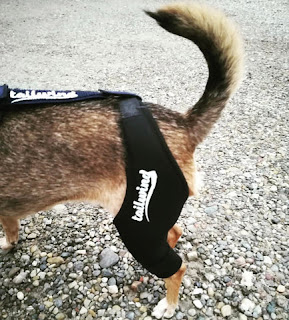Ensuring
the health and mobility of our furry companions is a top priority for pet
owners. One common issue dogs face, particularly as they age or if they are
very active, is knee problems. Knee braces
can provide essential support and alleviate pain, but choosing the right one
can be overwhelming. This guide will help you understand the different types of
knee braces for dogs and how to select the most appropriate one for your pet.
Understanding
Dog Knee Braces
Dog braces are designed to support the knee joint, reduce
pain, and improve mobility. They are particularly useful for dogs suffering
from conditions like arthritis, ligament injuries, and post-surgical recovery.
There are various types of dog knee braces, each serving specific purposes.
Types of Dog
Knee Braces
Standard Dog
Knee Braces
Standard
dog knee braces are typically made
of neoprene or similar materials and provide general support to the knee joint.
These dog braces
are ideal for dogs with mild to moderate knee issues and can help with
stability and pain reduction.
Custom Knee
Braces
Custom knee braces are tailored
to fit the specific measurements of your dog’s leg. These braces provide the
best fit and maximum support, making them ideal for dogs with severe knee
injuries or chronic conditions. A custom knee brace ensures that pressure is evenly distributed, reducing the
risk of further injury.
Hinged Knee
Braces
Hinged knee braces offer
additional support through metal or plastic hinges that mimic the natural
movement of the knee joint. These braces are excellent for dogs recovering from
surgery or those with significant ligament damage. Hinged knee braces provide stability while allowing for a range of
motion, promoting better healing and mobility.
Factors to
Consider When Choosing a Knee Brace for Dogs
Condition and
Severity
The
severity of your dog’s knee issue plays a crucial role in determining the
appropriate dog knee brace.
For mild conditions, a standard knee brace for dogs may suffice. However, for severe injuries or chronic conditions, a
custom or hinged knee brace is recommended for optimal support and recovery.
Fit and Comfort
A
proper fit is essential for the effectiveness of a dog knee brace. Measure your dog’s leg accurately and consider consulting
with a veterinarian or a professional who can recommend the best fit. A well-fitted
knee brace should be snug but not too tight, allowing your dog to move
comfortably without causing irritation or restricting blood flow.
Material and
Durability
Dog knee braces are made from various materials, including
neoprene, nylon, and metal. Choose a material that is durable and comfortable
for your dog. Neoprene is commonly used for its flexibility and comfort, while
metal hinges in hinged knee braces
provide additional support and stability.
Ease of Use
The
knee brace should be easy to put on and take off, especially if your dog is not
accustomed to wearing one. Look for braces with adjustable straps and secure
closures to ensure a snug fit and easy application.
Benefits of
Using Dog Knee Braces
Pain Relief and
Improved Mobility
Knee braces for dogs help reduce pain by
providing support and stability to the injured joint. This support alleviates
pressure on the knee, allowing your dog to move more comfortably and maintain
an active lifestyle.
Prevent Further
Injury
Wearing
a dog knee brace
can prevent further injury by stabilizing the joint and restricting harmful
movements. This is particularly important for dogs recovering from surgery or
those with chronic conditions that weaken the knee joint.
Enhanced
Recovery
For
dogs recovering from knee surgery, such as an ACL repair, knee braces can
significantly enhance the recovery process. Hinged knee braces, in particular, provide the necessary support while
allowing controlled movement, promoting better healing and faster recovery.
Conclusion
Choosing the appropriate dog knee brace involves understanding your dog’s specific needs and the severity of their condition. Whether you opt for a standard brace, a custom knee brace, or a hinged knee brace, ensuring a proper fit and comfort is crucial for effectiveness. Dog knee braces offer numerous benefits, including pain relief, improved mobility, and prevention of further injury. By selecting the right knee brace, you can help your furry friend lead a more comfortable and active life, ensuring their well-being for years to come.










